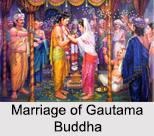 Gautama Buddha, the founder of Buddhist religion was known as Siddhartha in his early life. He was the prince of Kapilavastu, a small kingdom of the then India, which is closed to present day Nepal.
Gautama Buddha, the founder of Buddhist religion was known as Siddhartha in his early life. He was the prince of Kapilavastu, a small kingdom of the then India, which is closed to present day Nepal.
Early Life of Gautama Buddha
Siddhartha was born in the year 563 B.C. in a mango grove at a place called Lumbini. It is presently located in the foot hills of Nepal in the region bordering the present day India. His father, King Suddhodhana was a Sakya king. He married two sisters, Maya and Pajapati Gotami, who came from a princely family. Seven days after his birth his mother Maya died, leaving him to the care of her sister and his step-mother Mahajapati. Siddhartha was raised in extreme luxury so that no earthly pain and sorrow could touch him. It was foretold by the astrologers after his birth that he would become a monk when he would see an old man, a diseased man, a dead man and a monk.
Guards were posted to make sure that Siddhartha could not come in contact with the four men as described by the astrologers. King Suddhodhana placed his son in the magnificent walled estates with gardens, fountains, palaces, music and beautiful women. It is said that Siddhartha lived in three palaces, especially build for him.
 Marriage of Gautama Buddha
Marriage of Gautama Buddha
Prince Siddhartha was married to princess Yasodhara at the age of 16, who was a cousin of him. She was the daughter of a Sakya Chieftain called Suprabuddha. Later they had a son named as Rahul. Thus, throughout his early life, Siddhartha knew nothing about sufferings and had no idea about the real world outside the enclosures. Siddhartha spend 29 years of his life in Kapilavastu as the prince.
This article is a stub. You can enrich by adding more information to it. Send your Write Up to content@indianetzone.com




















